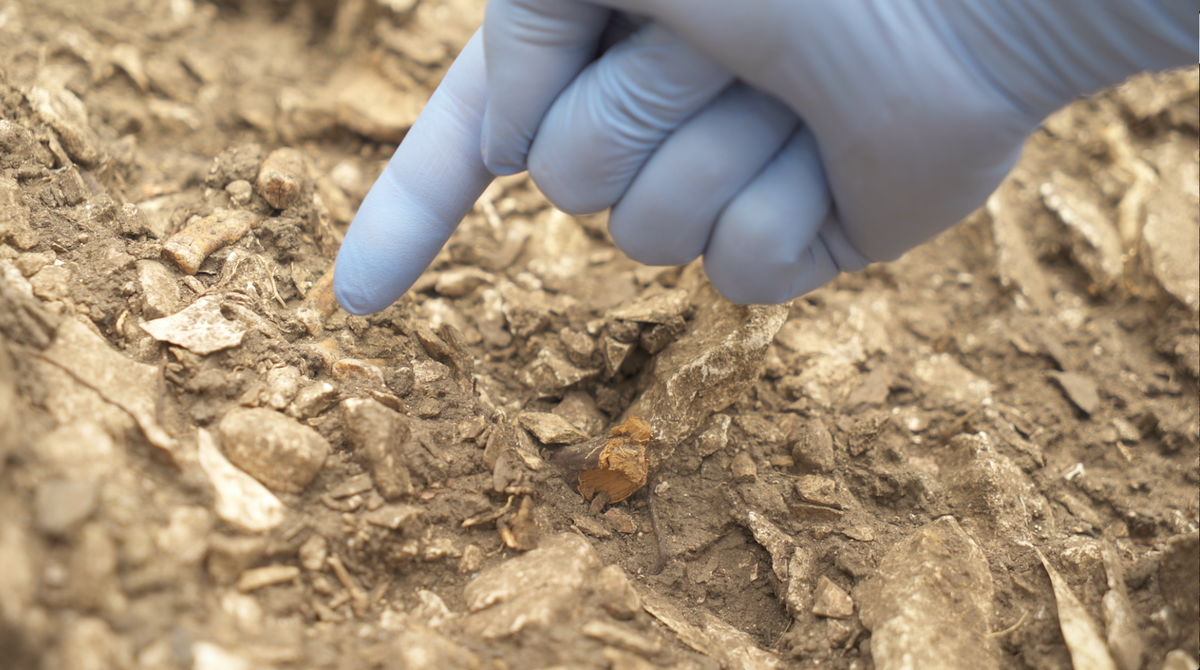Cave discovery in France may explain why Neanderthals disappeared, scientists say

The remains of a Neanderthal
(CNN) — When archaeologist Ludovic Slimak unearthed five teeth in a rock shelter in France’s Rhône Valley in 2015, it was immediately obvious that they belonged to a Neanderthal, the first intact remains of the ancient species to be discovered in that country since 1979.
However, the once-in-a-lifetime find, nicknamed Thorin after a character in “The Hobbit,” remained a well-kept secret for almost a decade while Slimak and his colleagues untangled the significance of the find — a fraught undertaking that pitted experts in ancient DNA against archaeologists.
“We faced a major issue,” said Slimak, a researcher at France’s National Centre for Scientific Research and Paul Sabatier University in Toulouse. “The genetics was sure the Neanderthal we called Thorin was 105,000 years old. But we knew by (the specimen’s) archaeological context that it was somewhere between 40,000 to 50,000 years old.”
“What the DNA was suggesting was not in accordance with what we saw,” he added.
It took the team almost 10 years to piece together the story of the puzzling Neanderthal, adding a new chapter in the long-standing mystery of why these humans disappeared around 40,000 years ago.
The research, published Wednesday in the journal Cell Genomics, found that Thorin belonged to a lineage or group of Neanderthals that had been isolated from other groups for some 50,000 years. This genetic isolation was the reason Thorin’s DNA seemed to come from an earlier time period than it actually did.
Until now, geneticists thought that at the time of extinction there was one Neanderthal population that was genetically homogeneous, but the new study reveals at least two populations were present in Western Europe at that time — and they lived surprisingly close to each other.
“The Thorin population spent 50,000 years without exchanging genes with other Neanderthal populations,” Slimak said in a news release.
“We thus have 50 millennia during which two Neanderthal populations, living about ten days’ walk from each other, coexisted while completely ignoring each other.”
Slimak said that the discovery suggested that Neanderthal communities were small and insular — factors that could be key to understanding their extinction because isolation is generally considered to be an evolutionary disadvantage.
Less genetic variation could make it harder to adapt to changing climate or disease, while less social interaction between groups makes it harder to share knowledge and technology.
“They were happy in their valley and did not need to move, while Homo sapiens all the time they want to explore, to see what is there after this river, after this mountain. (We have) this need, this need to move, and this need to build a social network,” Slimak said.
This pattern of small populations, isolated culturally and genetically from one another, was likely a major factor behind Neanderthal extinction, which occurred around the same time Homo sapiens arrived in Europe, he said.
DNA from Homo sapiens fossils from that time show that these early arrivals interbred with Neanderthals — traces of those encounters remain in present-day human populations. However, no corresponding genetic evidence of that interbreeding has been found in Neanderthal fossils from that time, including Thorin’s remains, the study noted.
Whatever behavior led to this lack of genetic intermingling on one side, along with small and isolated Neanderthal populations such as the one Slimak and his colleagues identified, likely contributed to the disappearance of the Neanderthals, said Chris Stringer, research lead in human evolution at London’s Natural History Museum who wasn’t involved in the study.
“Whatever the reasons for this imbalance (social, biological?) it contributed to the demise of the last Neanderthals, since their already small populations were losing reproductive age individuals to the other species, without any replenishment in return,” Stringer said via email.
“Coupled with economic competition from the newcomers over resources, this could have been a recipe for demographic collapse.”
It’s not clear whether Thorin’s full skeleton is interred within Grotte Mandrin, as the rock shelter in the Rhône Valley near Malataverne, France, is known. The remains were found near the surface in soft, unstable ground, and the excavation continues slowly, Slimak said, with archaeologists tweezing out “one grain at a time.” It’s also unclear whether the specimen, which is male, was deliberately buried or not.
Archaeologists have excavated more of Thorin’s remains: 31 teeth, part of the jaw and five finger bones, so far. The shape of his teeth is typical of a Neanderthal, but he had two extra lower molars — a trait sometimes suggestive of an inbred population, the study noted.
Genetic mystery resolved
The initial genetic analysis suggested that Thorin was much older because his genome was distinct from other later Neanderthals, resembling the genomes of ancient humans who lived more than 100,000 years ago.
To understand Thorin’s origins and confirm the age of his remains, the team analyzed chemical isotopes in his bones and teeth to infer what type of climate he lived in based on the water he would have drunk and other factors. A Neanderthal in Europe 105,000 years ago would have a enjoyed a much warmer climate than one living 45,000 years ago during the Ice Age.
“We worked for seven years to find out who was wrong — archaeologists or genomicists,” Slimak said in the news release.
Slimak has been involved in the excavation of Grotte Mandrin for more than three decades and made a number of exciting finds at the rock shelter. It’s the only known site to have been home to alternating groups of both Homo sapiens and Neanderthals, plus the earliest evidence of bow and arrow use outside Africa.
“Grotte Mandrin keeps delivering surprises,” Stringer said.
The-CNN-Wire
™ & © 2024 Cable News Network, Inc., a Warner Bros. Discovery Company. All rights reserved.